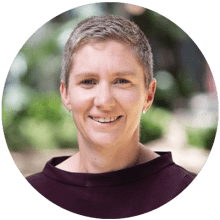Chief Conservation Regulator foreword
Kate Gavens
Chief Conservation Regulator
In Victoria we are lucky to have diverse wildlife, forests and protected places that support biodiversity and outdoor recreation.
The Conservation Regulator protects Victoria’s flora and fauna species and landscapes through education, monitoring, and enforcement of laws across biodiversity, public land use, wildlife, and bushfire prevention. We aim to focus our efforts in the areas that can make the biggest difference to our environment.
To guide this focus, we identify a set of regulatory priorities. These priorities are determined through a state-wide information gathering and risk assessment process. The goal is to understand and identify the greatest risks to Victoria’s public land, biodiversity, and wildlife. These priorities then inform where we direct our efforts.
Consistency in our regulatory priorities over the years, along with growth in availability of data and our intelligence holdings, has informed our decision to move from an annual to a two-year cycle for assessing priorities. This change will allow us to implement longer-term strategies and provide greater certainty to the community and stakeholders about our focus areas.
Our regulatory priorities for 2025 – 2027 are illegal fires on public land, illegal take of firewood, cruelty to wildlife, protection of threatened species, and illegal vehicle use.
We are encouraged by the increasing willingness of Victorians to get outdoors and engage respectfully and sustainably on public land. We will continue to collaborate with our regulatory partners, volunteer organisations, and colleagues across the Department of Energy, Environment and Climate Action to ensure our native landscapes are protected.
Effective conservation requires every Victorian to take part in protecting our environment and wildlife. Your actions – from following campfire safety rules to reporting illegal activities – directly contribute to the health of our forests and the welfare of our native species.
How we set and implement our priorities
Identifying our priorities
The Conservation Regulator is committed to protecting Victoria’s state forests, native wildlife, and biodiversity. We identify priorities to focus our efforts where they can make the biggest difference in preventing environmental harm.
To determine these priorities, we:
- Collect and analyse data about environmental conditions and compliance patterns.
- Identify emerging trends affecting our forests and wildlife.
- Undertake a state-wide risk assessment to determine the greatest risk and where intervention can best prevent harm.
- Collaborate and consult with our regulatory partners and colleagues across the Department of Energy, Environment and Climate Action.
- Consult with key stakeholders, including members of our Stakeholder Reference Group.
Understanding environmental and behavioural trends is central to our priority-setting process. For example, our intelligence gathering has shown that wildlife welfare concerns continue to increase, and we’ve observed changing patterns in how Victorians interact with public land.
We’re also seeing environmental conditions shift, with Victoria’s climate becoming increasingly dry and fire-prone, creating heightened risks during camping seasons and placing additional stress on already vulnerable ecosystems. These insights shape where we focus our regulatory efforts.
We’re continually refining our approach based on what we learn. After evaluating the impact of our previous regulatory priorities, we adjust our focus to ensure we best address emerging issues or strengthen our efforts in ongoing areas of concern, such as protecting threatened species and preventing cruelty to wildlife. In setting our priorities, we consider our regulatory responsibilities and opportunities to mitigate risk through collaboration. We work alongside other agencies and Traditional Owners to ensure our priorities complement government-wide efforts to address biodiversity decline, as outlined in Biodiversity 2037.
We publish our priorities, so Victorians know what to expect from us and understand our focus. This transparency helps build trust and encourages community participation in protecting our shared environment.
Implementing our priorities
The Conservation Regulator fulfils a range of core statutory functions under Victorian legislation, including issuing wildlife permits, monitoring compliance with environmental laws, and enforcing regulations that protect our forests and biodiversity. These essential responsibilities form the foundation of our work and continue regardless of changing priorities.
Our regulatory priorities guide where we direct our discretionary efforts – allocating resources to address the most significant threats to Victoria’s natural environment.
By focusing our discretionary activities on priorities like illegal fires on public land and wildlife cruelty, we can design targeted education campaigns, conduct strategic compliance operations, and deploy enforcement resources where they’ll have the greatest impact. This approach ensures we meet our legislative obligations while concentrating our additional efforts on preventing the most serious environmental harms.
The result is more effective protection of Victoria’s environment through a balanced combination of mandatory regulatory functions and directed discretionary work that responds to the greatest environmental risks.
Setting clear priorities helps us use our resources wisely, ensuring our staff focus on activities that protect the environment most effectively. We’re improving our approach through technology – from digital reporting systems to remote monitoring tools – that allows us to cover more ground and detect risks earlier. This combination of strategic planning and modern tools helps us maximise our impact.
Two-year cycle
The Conservation Regulator is moving from a yearly to every-two-years regulatory priority risk assessment.
This reflects our improved regulatory maturity and the relatively consistent nature of the risks we manage. Over several years, we’ve seen that most of our priorities – illegal campfires, firewood theft, wildlife cruelty, threatened species protection, and illegal vehicle use – have remained largely unchanged year to year. We believe this suggests we’re on the right track and these issues would benefit from ongoing attention rather than frequent reassessment.
This two-year approach lets us work more efficiently by focusing our time on actions that protect our environment. We’ll focus more on prevention, education, and measuring our results over longer periods. We’ll be sure to keep a close eye on any new risks that emerge between assessments to ensure Victoria’s natural environment remains well‑protected.
Trends
Wildlife trafficking networks
Reports of illegal wildlife trafficking are increasing across Victoria.
A recent strategic operation with Agriculture Victoria – Operation DJANGO – revealed increasingly sophisticated illegal trafficking operations involving both native and exotic wildlife species. This illegal trade puts our local plants and animals at risk by potentially introducing diseases and disrupting ecosystems. Trafficked animals also suffer cruel conditions during capture and transport, with many dying before reaching their destination. Wildlife trafficking is recognised as one of the world’s largest illegal trades, worth approximately $20 billion annually. Our priority is to disrupt these networks through intelligence-led operations and cross-agency collaboration.
Changes affecting land use
National and global cost of living pressures are influencing how Victorians interact with public land.
We’ve observed an overall increase in demand for firewood. Simultaneously, we’ve seen an increase in both unauthorised encampments and illegal dumping on public land – particularly in peri-urban areas. Our approach balances regulation with community support, focusing enforcement on cases causing significant environmental harm while working with partner agencies to connect people with appropriate services and information about legal alternatives. This ensures we protect our natural assets while responding compassionately to community needs.
Changing and challenging climate
Victoria is experiencing increasingly unpredictable weather patterns.
The Bureau of Meteorology forecasts warmer than average conditions for much of the state in 2025-2026, heightening bushfire risks in areas still recovering from previous fire events. Rainfall patterns are becoming more variable, with both extended dry periods and intense downpours affecting land condition and accessibility. These altered regimes are affecting vegetation recovery cycles and creating new compliance challenges. For example, we need to be increasingly responsive in implementing fire prevention measures and managing seasonal road closures that protect both visitors and sensitive environments during dangerous weather conditions or when tracks are vulnerable to damage. Our approach must adapt to these changing conditions while ensuring public safety and environmental protection.
Digital conservation technologies
New technologies are changing how we monitor and protect biodiversity.
Citizen science apps like iNaturalist and FrogID have made data collection accessible to everyone, with Australians contributing millions of wildlife observations last year – bolstering public knowledge of wildlife ranges and behaviour. Environmental DNA (eDNA) sampling is also improving threatened species detection by finding genetic traces in water and soil, while drones equipped with thermal cameras are helping to confirm wildlife presence and population. The Conservation Regulator is increasingly incorporating these data sources to complement our compliance operations. As these tools become more widespread, they create new opportunities for better ecosystem management and public participation in conservation.
Biodiversity decline
The diversity of Victoria’s plants and animals continues to decline.
Environmental assessments show how habitat destruction, forest fragmentation, and increased fire intensity and variability are disrupting recovery patterns. Native species face growing challenges from invasive predators, weeds, and changing land use. This decline weakens vital ecological networks that support healthy environments. We focus on preserving important habitat like hollow-bearing trees that shelter wildlife, protecting movement corridors for animals, and helping people connect with nature – recognising that those who value natural spaces are more likely to help protect them.
Threatened species success stories
Conservation efforts for some of Victoria’s endangered wildlife are showing encouraging results.
The helmeted honeyeater, Victoria’s bird emblem, has increased its wild population from fewer than 50 birds in 2019 to over 200 today through habitat restoration and breeding programs. The eastern barred bandicoot has been saved from extinction through successful reintroductions to predator-free environments on Phillip, Churchill and French Islands. These recoveries demonstrate the potential of coordinated action between government agencies, conservation organisations, and communities. Community volunteers and landowners are increasingly supporting these efforts by contributing to habitat improvement and protection, and by monitoring wildlife. Despite ongoing challenges, these success stories show how targeted conservation can help our most vulnerable species recover.
Regulatory priorities
The Conservation Regulator’s state-wide regulatory priorities for 2025 – 2027
Illegal fires on public land
Bushfires caused by illegal fires such as campfires and deliberate ignitions by arsonists continue to pose a serious threat to Victoria’s communities, wildlife, and natural landscapes.
Bushfires remain one of Victoria’s most devastating natural hazards. The consequences often extend beyond immediate destruction – they disrupt ecosystems, threaten biodiversity, and alter natural fire regimes that our native species have evolved with over millions of years. For the 2025 – 2027 period, illegal fires remain a core priority of the Conservation Regulator.
Recent data shows a concerning trend in campfire-related incidents. Our officers detected 578 unattended campfires in 2024, following 601 detections in 2023 – both years representing elevated observation levels compared to 459 in 2022 and 484 in 2021. High-risk areas include the Grampians, Alpine regions, and Cape Otway. These risks peak during our summer months from December through February, when a single campfire can have catastrophic consequences.
Our approach combines education with compliance monitoring. We continue to deploy targeted patrols during high-risk periods, conduct community education programs, and use data-driven strategies to identify hotspots requiring additional attention. We’re also working to continuously improve the information available about campfires so that everyone knows what a safe campfire is.
Our staff collaborate with Forest Fire Management Victoria, Parks Victoria and Traditional Owners, combining diverse expertise to protect Victoria’s environment. This includes joint patrols with Forest Fire Management Victoria that detected over 40 illegal campfires during a single Labor Day weekend Total Fire Ban. These partnerships represent an integrated, state-wide conservation and risk management effort. We continue to work with Victoria Police on high risk and known areas for deliberate ignitions by arsonists.
We’re committed to helping Victorians enjoy our landscapes safely while protecting what makes these places special.
The simple act of properly extinguishing a campfire can save lives, homes, and habitats.
Case study Unattended campfire forces 150 people to flee at Cape OtwayIn January 2025, a preventable bushfire at Cape Otway demonstrated the devastating potential of illegal campfires. Emergency services responded to a rapidly spreading fire near Blanket Bay Road at 2:20am, forcing the urgent evacuation of more than 150 people from nearby campsites. The fire burned approximately 14 hectares of environmentally sensitive bushland – home to numerous native species including koalas and rare orchids – before being controlled. Investigators determined the cause was an unattended campfire that had not been properly extinguished. Since July 2024, Forest Fire Management Victoria and Country Fire Authority have responded to almost 250 incidents involving campfires, highlighting why the Conservation Regulator continues to prioritise campfire safety through education and enforcement. The Cape Otway incident shows how one careless act can endanger lives, disrupt communities, and damage sensitive ecosystems. The Conservation Regulator encourages the public to report unattended campfires to 136 186, or in an emergency to 000. |
Remember these simple rules when camping
- Review the Can I? Can’t I? brochure(opens in a new window) and don’t forget to take a bucket and water
- Never leave a campfire unattended
- Use a designated fireplace where provided
- Clear area around the campfire of flammable material (minimum 3 meters)
- Completely extinguish with water, not soil
- Check weather conditions and fire bans before lighting any fire
Total Fire Ban and Fire Danger information
- VicEmergency Hotline 1800 226 226
- Visit emergency.vic.gov.au
- Install Vic Emergency app
Report unattended campfires
- Check campfire rules(opens in a new window)
- Report unattended campfires to 136 186, or in an emergency 000
Illegal take of firewood
Firewood taken illegally from Victoria’s forests continues to destroy vital wildlife habitat impacting biodiversity and cultural heritage across the state.
Illegal firewood collection is an ongoing priority for 2025 – 2027. When trees, logs, and woody debris are unlawfully removed from public lands, they take with them irreplaceable habitat needed by native species. These seemingly simple forest elements are complex ecosystems in themselves – providing food sources, nesting sites, and protection from predators. Illegal collection also poses a significant risk to Aboriginal cultural heritage, potentially destroying scarred trees and other culturally significant sites.
Particularly vulnerable are the iconic river red gum ecosystems along the Murray, Goulburn, and Loddon Rivers, where ongoing monitoring reveals concerning patterns of habitat removal. These ecosystems are integrated habitats for threatened species like the superb parrot, Murray cod and winged peppercress.
The scale of this problem is significant – approximately 9,200 trees are illegally cut down annually from parks, forests, and reserves.
In 2023 – 2024, we laid 248 charges linked to illegal firewood removal. Commercial activity is a major concern, with 44 per cent of reported firewood theft recorded in 2023 – 2024 showing commercial intent through volumes taken, equipment used, or sales intelligence.
Our approach balances education and enforcement with community support. We continue to enhance surveillance in high-risk areas, conduct targeted operations with partner agencies, and provide information about legal firewood collection opportunities. Our focus is illegal operators who remove commercial quantities from public land, destroying critical habitat and selling to often unsuspecting buyers. We also recognise that cost-of-living pressures drive some illegal collection and work to address this through community education about trusted suppliers and sustainable alternatives.
In 2023, we created Taskforce Ironbark. Through the taskforce we are partnering with Parks Victoria and are focusing on continuing targeted action on firewood theft from public land and raising community awareness through targeted patrols, intelligence-gathering, and education campaigns.
Each year, Victorians can legally collect firewood for domestic purposes during two seasons: autumn and spring. You can only collect from designated areas for your own home use. Before heading out, check the Forest Fire Management Victoria website for maps showing exactly where collection is allowed in your area.
Case study Taskforce Ironbark targets illegal commercial firewood harvestersIn 2023, we created Taskforce Ironbark in partnership with Parks Victoria, to target firewood theft from public land that damages our natural environments, and help the community understand how to source firewood legally and sustainably. The taskforce specifically targets large-scale, commercial take – focusing on operators that illegally harvest commercial quantities of firewood for profit. We focus our efforts where firewood theft is causing the most environmental harm, based on evidence and intelligence. Our officers use several methods to detect illegal activity, including targeted patrols in high-risk areas and strategic placement of surveillance equipment. This allows us to identify patterns of illegal firewood removal and take appropriate action to protect sensitive forest ecosystems. These activities particularly impact high biodiversity areas and cultural sites. Thieves often target large dead standing trees that provide crucial habitat for threatened species like the red-tailed black cockatoo and brush-tailed phascogale. In Metcalfe State Forest, enforcement action addressed illegal timber felling that destroyed habitat for sugar gliders, white-throated treecreepers, and Bougainville’s skinks. Taskforce Ironbark now uses a geospatial tool that overlays Strategic Biodiversity data with illegal firewood reports, helping focus enforcement where environmental harm is greatest. With reports concentrated in Gippsland, Grampians, Loddon Mallee, and Port Phillip regions, we continue to rely on public vigilance to protect our forest ecosystems. |
Domestic firewood collection seasons
| Autumn | 1 March | – | 30 June | DESIGNATED AREAS ONLY |
| Spring | 1 September | – | 30 November |
Collect firewood legally
Report illegal firewood collection
Penalties apply to anyone caught illegally taking or selling firewood from public land
Report suspicious behaviour by calling 136 186
Cruelty to wildlife
Cruelty to wildlife is unacceptable and requires a proactive and preventative approach. Cruelty to wildlife, whether in the wild or in captivity, is not acceptable, is unlawful and does not align with the values of the Victorian community.
Wildlife cruelty can involve deliberate harm to wild animals or inadequate care of captive wildlife, resulting in suffering or death. This cruelty undermines our collective responsibility to protect Victoria’s unique native species and threatens the biodiversity that makes our state unique.
The Conservation Regulator prioritises preventing and addressing wildlife cruelty through education, enforcement, and partnerships. We focus on the most significant and intentional cases, especially those impacting large wildlife numbers, such as mass poisoning events of wildlife in the wild, or intensive breeding facilities for captive wildlife to support captive demand – these facilities often compromise wildlife welfare through overcrowding, poor care and housing conditions.
We issue wildlife licences and permits with strict conditions to support animal welfare and conduct targeted inspections to ensure compliance.
Our officers investigate reports of illegal destruction, injury, or disturbance of wildlife, breaches of wildlife licences and authorities, and the illegal acquisition and transport of wildlife.
By working alongside Crime Stoppers, RSPCA, Animal Welfare Victoria, Victoria Police and inter-jurisdictional colleagues, we support an active network addressing wildlife cruelty and supporting affected animals. This work will continue through 2025 – 2027, as we prioritise cases of significant cruelty aiming for prevention and stopping existing harm.
Victorians can help by reporting wildlife cruelty to Crime Stoppers, including instances where captive wildlife isn’t provided with adequate care or where wild animals are being harassed, disturbed, or harmed.
In Victoria, it is illegal to disturb or destroy wildlife without proper authorisation.
Case study Operation DJANGO protects native wildlife from exotic animal tradeWildlife trafficking is a $20 billion global illegal industry that threatens Victoria’s biodiversity and causes animal suffering. Smuggled exotic animals can carry diseases harmful to native wildlife, pets, and humans. When evidence revealed sophisticated exotic animal trafficking across Victoria, the Conservation Regulator and Agriculture Victoria launched Operation DJANGO to combat this growing threat. The operation targeted illegal traders dealing in exotic species that pose serious biosecurity risks. Through coordinated enforcement, the team seized 16 exotic animals including African pygmy hedgehogs, prohibited snakes, tortoises, and a green iguana. The investigation also uncovered illegal trading of protected native species including crocodiles and pythons. Nine offenders have faced consequences, with fines totalling $115,600 – including a record $54,000 penalty under Victoria’s Catchment and Land Protection Act 1994. Community reporting remains crucial. If you have information about illegal wildlife trading, contact Crime Stoppers Victoria on 1800 333 000 or crimestoppersvic.com.au. |
Report wildlife crime
Report wildlife crime to Crime Stoppers on 1800 333 000
Callers can remain anonymous
Protection of threatened species
Victoria’s native plants and animals are fundamental to a healthy natural environment and are protected by law.
Victoria’s terrestrial and freshwater habitats support some 80,000 – 100,000 species, including 3,600 plants and more than 600 vertebrates. Just over 2,000 species are listed as threatened, including over 200 vertebrate fauna and over 1,600 flora species – highlighting both the richness of Victoria’s biodiversity and the scale of what’s at risk.
Victoria’s biodiversity faces serious challenges as threatened species populations continue to decline. When we lose even one species, we damage the complex web of relationships that keeps our ecosystems functioning. These native species have evolved to play specific and vital roles in our environment – from pollination to pest control to supporting soil health.
Monitoring by both government and citizen science show concerning long-term population declines across many threatened species. According to Victorian State of the Environment Report 2023, habitat loss, altered fire regimes, invasive species, and illegal removal of plants and wildlife continues to drive these declines.
The Conservation Regulator contributes to a government-wide effort to reverse these declines. We have identified which species are most directly impacted by illegal activity, developing focused campaigns targeting these specific species and activities. We identify and prioritise investigating illegal take and trafficking of the most vulnerable species and conduct proactive patrols where these species are at greatest risk.
Many of our iconic species face challenges – from coastal beach nesting hooded plovers vulnerable to disturbance, to endangered southern right whales that need protection in their only established nursery in south-east Australia at Logans Beach. By combining enforcement with education and partnerships with Traditional Owners, we’re creating pathways for Victoria’s threatened species to recover and thrive in the years ahead.
For example, Operation Save our Hoodies, where we work in partnership with Birdlife Australia and volunteers, has contributed towards an increase in the number of hooded plover chick survival to fledgling by 50 per cent in the last breeding season. Our new Focus Species Program is helping people understand how small changes can make a big difference for wildlife. New digital tools are helping us identify areas of high biodiversity value, allowing for more strategic protection efforts. Despite the remaining challenges, these are positive outcomes.
Victorians can help by learning about local threatened species and reporting suspected illegal activities affecting them.
Case study Enforceable undertaking to protect threatened grasslandsIn May 2025, Powercor Australia entered into an Enforceable Undertaking with the Conservation Regulator following an extensive investigation into damage of threatened native grasslands and flora at 36 sites across Victoria. The investigation examined vegetation management and maintenance activities carried out by Powercor in 2023 and 2024, which impacted areas of high conservation value. These included part of the Western (Basalt) Plains Grasslands Community – one of the most endangered vegetation communities in Australia, having been reduced to less than 2 per cent of its original extent since European settlement. This grassland environment is home to a rich diversity of threatened wildflowers and is a known breeding site of the endangered Eltham copper butterfly in Central Victoria. The Enforceable Undertaking commits Powercor to a comprehensive program of environmental improvements, including strengthening its internal environmental processes and staff knowledge of relevant legislation, preventing unnecessary harm to protected flora and fauna during future maintenance works, and remedying damage at 32 agreed sites with progress reporting until the undertaking concludes in May 2028. |
Report illegal take or damage of threatened flora
- Conservation Regulator encourages anyone with information about wildlife crime to report it to Crime Stoppers on 1800 333 000
- Report illegal take or damage of threatened plant or animals to 136 186
Illegal vehicle use
Illegal off-road vehicle use damages our environment and risks the safety of other forest users. When vehicles drive off designed roads and tracks, they cause lasting harm to Victoria’s forests and natural landscapes.
Tyre tracks crush native vegetation, disturb habitat, and create erosion that can take decades to heal. This damage fragments ecosystems, spreads invasive flora species, and degrades the water quality of streams and waterways.
In one documented case, over 600 kilometres of illegal single tracks were created in the Great Otway National Park and Otway Forest Park. These tracks damaged rare heathlands that contain plant species found nowhere else on Earth. The Otway region has existed for roughly 140 million years, and these heathlands are among the last remaining patches of natural vegetation in south-western Victoria that haven’t been cleared for farming or development.
Protecting these unique landscapes is one of our highest priorities.
Through targeted operations like Operation Sprocket, we engage directly with recreational riders and drivers at popular forest locations and community events.
With funding support from the Transport Accident Commission, our approach combines education with enforcement – providing safety resources while using advanced surveillance techniques to identify those responsible for environmental harm.
Victoria’s state forests, parks and reserves contain over 30,000 kilometres of formed roads and tracks for legal vehicle use. By staying on these designated routes, visitors can enjoy our forests while helping protect the values that make visiting worthwhile.
We’re finding ways to balance enjoyment of our forests with their protection. Our shared goal is ensuring these special landscapes remain healthy for everyone to experience.
Sticking to formed roads isn’t just better for the environment – it’s safer for everyone.
Case study The diverse impacts of illegal vehicle useIllegal vehicle use on public land takes many forms, each causing different but significant environmental damage. In the past year, Conservation Regulator Authorised Officers have responded to numerous incidents throughout Victoria: During seasonal road closures designed to protect sensitive areas during wet periods, several drivers ignored barriers and warning signs, causing deep rutting and erosion that will take years to rehabilitate. These actions not only damaged the roads but created dangerous conditions for other forest users. On coastal areas, vehicles driving through restricted beach zones can disturb critical shorebird nesting sites, including threatened hooded plovers. These vulnerable beach-nesting birds have specific habitat requirements and are particularly susceptible to human disturbance. Illegal off-track driving through river crossings can significantly damage waterways, increasing turbidity and harming aquatic habitats. Vehicles bypassing designated tracks can crush vegetation that is critical for preventing streambank erosion, leading to sediment pollution that affected downstream water quality. Illegal vehicle use damages our natural areas across Victoria. When people drive off-road or ignore closures, they harm forests, habitat, and waterways. These aren’t quick fixes – the damage can last for years. |
Help protect our special natural places
- Check which roads and tracks are open for vehicle use before heading out(opens in a new window)
- Report illegal off-road activity to 136 186
Talk to the Conservation Regulator
If you see something, let us know. Report environmental crimes on public land to the Conservation Regulator.
| Phone | DEECA Customer Contact Centre 136 186 |
| Email us at conservationregulator@deeca.vic.gov.au | |
| Report wildlife crime | Phone Crime Stoppers Victoria 1800 333 000 Visit crimestoppersvic.com.au/report-a-crime(opens in a new window) |
| Online | Visit conservationregulator.vic.gov.au |
| Follow us on Facebook @conservationreg(opens in a new window) | |
| X (Twitter) | Follow us on X (Twitter) @conservationreg(opens in a new window) |
| Accessibility | If you are deaf or have a hearing or speech impairment, contact us through the National Relay Service on 133 677 or visit accesshub.gov.au |
Download PDF
Updated







